Students learn a valuable lesson in shop economics when they compare tools sharpened with conventional abrasive and superabrasive wheels.
Teacher Robert Romanowski could have chosen to use the pre-fab curriculum he was handed without modification. The lesson plans and audiovisuals he had received as part of a program developed by GE Superabrasives, Worthington, OH, would have done a sufficient job of teaching his students how to use diamond and cubic boron nitride (CBN) tools and wheels. But Romanowski, an industrial-arts teacher at Ohio Hi Point Vocational School, Bellefontaine, had a more ambitious plan in mind—one that would give his students a lesson in real-world shop economics while it tested the claims being made in favor of superabrasive tool grinding.
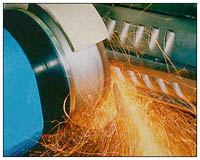 |
| As the students at Ohio Hi Point Vocational School discovered, grinding tools with superabrasive wheels can significantly increase tool performance and reduce tool and wheel costs. |
With his students' participation, Romanowski set up a year-long experiment that pitted two tool-sharpening wheels against each other. One wheel was made with aluminum-oxide (Al2O2) abrasive, while the other used CBN. At the end of the year, the students were to compare the records they kept on tool and wheel wear and decide which wheel would be the better choice.
GE set up the original program to introduce the use of superabrasive wheels and tools to shop students. Although GE makes neither tools nor wheels, it does manufacture much of the diamond and CBN the manufacturers use to make their superabrasive products.
GE's plan was to use teachers to get the word out about superabrasives. The company designed its program as a class that teachers would attend. At the class, the teachers were given the information and resources they would need to teach their students about superabrasives. "We put together an educational series of seminars, usually about twice a year, as well as a textbook and lesson plans, overheads, slides, videotapes, and everything that was necessary to put on a course on the concept of superabrasives," says Alan Carius, GE's manager, industrial programming. "This included diamond grinding, CBN grinding, and machining with diamond and CBN, among other things."
GE held the program's week-long seminars for teachers at its Ohio facility. Educators from across the United States attended the sessions, Carius says. Some even came from other countries. During their stay, the teachers learned about how to use superabrasive tools and wheels. Then, they were given a chance to practice their newly gained knowledge in hands-on sessions in GE's laboratory. Armed with this information and GE's educational materials, the teachers were then sent back home to pass this knowledge on to their students. The schools worked with manufacturers of wheels and tools to obtain the products that the students were to use for hands-on experience with superabrasives. "There was a network of grinding-wheel manufacturers and cutting tool manufacturers throughout the world that agreed to partner in this whole educational program," says Carius.
GE administered this program for three years, according to Carius. The company has since spun it off to the Industrial Diamond Association of America Inc. (IDA), Skyland, NC. Fred Gray, IDA's executive director, says the association conducted some sessions a year-and-a-half ago, but the program is currently being retooled. Using the materials supplied by GE, the association has been educating both machinists and teachers and granting certification in the use of superabrasives to those who pass the course. The restructured program will continue to offer this training and certification. For more information, call IDA at (828) 684-1986 or fax (828) 684-7372.
The Case for Superabrasives
In addition to providing information and lesson materials, the program gave GE a chance to sell students on the benefits of superabrasives, knowing that one day some of those students might be in positions to influence their shops' buying decisions. The materials and information GE disseminated ranged from the practical to the theoretical, covering not only the use of CBN and diamond, but also "what the potential benefits would be," says Carius.
GE bases its case for superabrasives on economics. According to GE, the use of superabrasive tools and wheels can result in significant cost savings despite an initial cost that can be as much as 30 times the price of other tools and wheels. GE arrived at this conclusion by calculating not only the money saved in direct machining costs, but also savings in indirect costs such as the labor that is no longer needed for wheel changes or the extended life of a tool ground with a superabrasive wheel. "The simplistic formula of price divided by parts produced will generally miss the hidden costs of using superabrasives entirely and, at best, grossly underestimate them," says a paper GE presented at a 1991 superabrasives conference.
TM
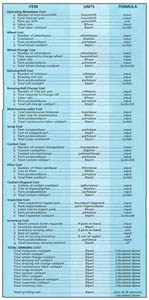 |
|
Table 1: This worksheet was designed to help end users consider all of the cost factors when comparing the performance of conventional and superabrasive wheels. (Click for larger image) |
The paper included a worksheet to help users calculate the total costs for machining or grinding with conventional and superabrasive tools and wheels (Table 1). Cost factors on the chart include the money it costs a shop to purchase wheels, dressing rolls, coolant, and coolant filters; dispose of coolant; maintain an inventory of parts in process; and pay workers to change wheels and dressing rolls, maintain equipment, and inspect parts.
Testing GE's Claims
Romanowski heard all the arguments in favor of superabrasives when he attended one of GE's seminars. He came away with the same materials and information as the rest of the group. But the teacher wasn't content to simply present the gospel according to GE. He had a notion to put some of GE's claims to a test. Specifically, he wanted to verify GE's assertion that a superabrasive wheel could do a superior job of sharpening tools.
Romanowski's idea was to use his students as the researchers. In the process, they'd learn not only how to sharpen tools and care for the tool-grinding wheels and equipment, but also how to monitor tool and wheel use and make an economic evaluation of tool and wheel performance.
The experiment Romanowski set up employed two manual toolgrinders installed in the shop class's toolroom. Each grinder was equipped with a 4" flaring-cup wheel. The Al2O3 wheel was a Z8A100H8V. The CBN wheel was an AB-120-N-100-B1/16(11V9). Each of the first-year machine tool technology students was given two DoALL (M-5) BriteLineŞ 3/4" endmills. One tool in each pair was branded with an "A" to tell the student to sharpen it only with the Al2O3 wheel. The other endmill was marked with a "B" to tell the student to sharpen it with the CBN wheel. New tools issued to students throughout the year were marked the same as the tools they replaced. The students were then taught how to determine when the endmills needed sharpening or replacing and shown the specific steps required to bring a tool back to usable condition. They also were taught how to maintain the grinding wheels and how to replace them as needed.
The students also were shown how to keep track of tool resharpenings in a log. Each time a tool was resharpened, the student recorded the date and the time of the job, the specific geometry that was ground, and, to determine how much stock was removed with each resharpening, the size of the tool before and after it was ground.
The students maintained a log of grinding-wheel maintenance as well. The log showed when and by whom the wheel was mounted and trued, when cutters were sharpened using the wheel, and when the wheel was dressed.
And the Winner Is. . .
The students continued to sharpen their tools as instructed and record the data throughout the school year. Their assignment was to use the data they had gathered to determine which type of wheel was the most economical to use. Romanowski also asked them to explain how and why they reached their conclusions. To evaluate the tools and wheels, the students were told to compare the number of grinding wheels used, the number of endmills sharpened between wheel dressings, the average amount of stock removed from each endmill when it was sharpened, and the approximate cutting time that elapsed between sharpenings with each tool.
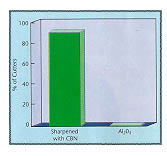 |
| Figure 1: When compared to Al2O3- sharpened endmills, a much larger percen of CBN-sharpened tools lasted the entire school year. (Click for larger image) |
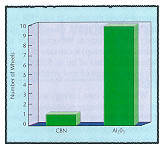 |
| Figure 2: Romanowski's class used only on CBN wheel to sharpen tools all school year. They needed 10 Al2O3 wheels to sharpen a similar number of endmills. (Click for larger image) |
The class's findings seemed to support GE's claims. According to the students' records, nine out of 10 endmills sharpened with the CBN wheel lasted the entire school year (Figure 1). None of the tools sharpened with the Al2O3 wheel made it through the entire year. The students also found that, on average, CBN-sharpened cutters could make chips 60% longer than Al2O3 sharpened tools before they needed resharpening.
Using a 505 optical comparator, the students also took a close look at the cutting edges of the endmills after sharpening the tools. In the students' opinion, the finish of the primary and secondary angles of the CBN-sharpened endmills was smoother than that of the Al2O3sharpened tools, and the tools had significantly fewer burrs.
The students found that the superabrasive wheels themselves lasted longer than the Al2O3 wheels. In fact, only one CBN wheel was used for the entire year. During the same period, 10 Al2O3wheels were needed (Figure 2). What the students didn't realize is that the CBN wheel had already been used by other classes for the last three years. While the CBN wheel never required dressing, each Al2O3 wheel required an average of 12 to 14 dressings during its service life.
The Hard Facts
As these findings indicate, the CBN wheel significantly outperformed the Al2O3 wheels. Not only was it able to sharpen more tools than any single Al2O3 wheel, but after sharpening, the tools performed better.
Carius claims that CBN's hardness is responsible for its superior performance as a tool-sharpening abrasive. CBN is the second-hardest substance known - second only to diamond. CBN is about 4800 on the Knoop scale,
Carius explains; Al2O3 is about 2100. Because the CBN grains are so hard, they remain sharp even when they are used to grind hardened tool steels. At less than half the hardness, Al2O3tends to dull more quickly, generating frictional heat. CBN also is a good thermal conductor, again, second only to diamond. By contrast, Al2O3 is a thermal insulator. "When you have contact between the Al2O3 grains and the steel that it's grinding, the steel is much more conductive," Carius says. "Therefore, the heat will go into the workpiece."
Carius says the effects of grinding with Al2O3 can be seen when a piece of thin metal is ground with an Al2O3 wheel on a surface grinder. The rapid heating and cooling cycles that result from the grinding operation create tension on the surface of the workpiece. "The surface wants to shrink," says Carius. "Therefore it tends to curl upward." This thermal cycling might also cause minute fissures in the workpiece's surface. These flaws allow cracks to propagate and can lead to premature rupture of a critical component. The heat that is generated during tool resharpening causes the hardness of the cutting edge to drop dramatically, according to Carius, and this leads to a reduction in the life of the tool.
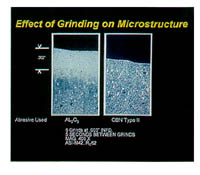 |
| Figure 3: These images show the difference in microstructure damage caused by Al2O3 and CBN wheels when grinding M-42 steel. |
A hard, sharp CBN grain, on the other hand, can continue to cut into the tool's surface long after a dulled Al2O3 grain has begun rubbing and generating heat. The grinding process does produce some heat, but this is handled by the grain's thermal conductivity. "The flash of heat that's generated as the chip is produced can be absorbed by the CBN crystal," claims Carius. "Then it will either be released into the bond system of the grinding wheel or be cooled by the air or the coolant or whatever comes in contact with it. The heat is not sent into the workpiece at nearly the rate that you would find with Al2O3." With less heat, there's less damage. Hence, the tools ground with CBN last longer, and they are ground smoother as well (Figure 3).
The hardness of the CBN grain also accounts for the wheel's longevity. The wheel remains sharp, and the grinding ratio, which is the ratio of workpiece material removed to wheel material lost in the process, remains high. Carius says this ratio is nearly 1000-to-1 when grinding M-2 tool steel. An Al2O3's ratio when grinding this material is around 5-to-1. In other words, when removing the same amount of material from the cutting edge of an endmill, the Al2O3wheel will wear about 200 times faster than the CBN wheel.
To put it in economic terms, the longer life of the CBN wheel more than compensates for the wheel's higher cost, according to Carius. The Al2O3flared-cup wheel Romanowski's class was using costs between $10 and $20 while the CBN wheel costs between $150 and $200. When you add in the Al2O3 wheel loss caused by the required wheel dressings (a loss that does not occur with CBN wheels because they do not require dressing after the initial wheel setup) it can take 50 to 100 wheels, at a cost of up to $2000, to do the same amount of tool grinding as one CBN wheel.
When other cost savings are factored in, an even stronger economic case for CBN wheels can be made, says Carius. Tool costs are reduced because the tools last longer when reground with CBN wheels, machine maintenance is reduced because there's no Al2O3 grit getting into the works, and chips can be recycled because they aren't contaminated with wheel material.
These benefits have made CBN the abrasive of choice for tool sharpening, says Carius. Tool grinding was one of the first applications for CBN wheels, and it continues to be one of the most common uses for superabrasive wheels. Carius cites the use of CBN wheels to grind hardened T-15 high-vanadium tool steel. Wheels made with conventional abrasives can't cut it effectively, he says. The material's toughness makes the use of a CBN wheel almost mandatory.
As the students in Romanowski's class discovered, the benefits that can be gained from the use of a hard, thermally conductive abrasive can be dramatic. As they tested and verified GE's claims for CBN, the kids saw first-hand what CBN wheels can do. They also learned how important tool and wheel performance are to productivity and how to evaluate performance from an economic standpoint. These valuable lessons weren't learned through stuffy lectures, however, where the students mechanically copied soon-to-be-forgotten facts and figures from the blackboard. Through Romanowski's creative use of the teaching materials he was given, his students could see for themselves the benefits of high-performance tools while they were learning the fundamentals of their trade.
Related Glossary Terms
- abrasive
abrasive
Substance used for grinding, honing, lapping, superfinishing and polishing. Examples include garnet, emery, corundum, silicon carbide, cubic boron nitride and diamond in various grit sizes.
- coolant
coolant
Fluid that reduces temperature buildup at the tool/workpiece interface during machining. Normally takes the form of a liquid such as soluble or chemical mixtures (semisynthetic, synthetic) but can be pressurized air or other gas. Because of water’s ability to absorb great quantities of heat, it is widely used as a coolant and vehicle for various cutting compounds, with the water-to-compound ratio varying with the machining task. See cutting fluid; semisynthetic cutting fluid; soluble-oil cutting fluid; synthetic cutting fluid.
- cubic boron nitride ( CBN)
cubic boron nitride ( CBN)
Crystal manufactured from boron nitride under high pressure and temperature. Used to cut hard-to-machine ferrous and nickel-base materials up to 70 HRC. Second hardest material after diamond. See superabrasive tools.
- cubic boron nitride ( CBN)2
cubic boron nitride ( CBN)
Crystal manufactured from boron nitride under high pressure and temperature. Used to cut hard-to-machine ferrous and nickel-base materials up to 70 HRC. Second hardest material after diamond. See superabrasive tools.
- dressing
dressing
Removal of undesirable materials from “loaded” grinding wheels using a single- or multi-point diamond or other tool. The process also exposes unused, sharp abrasive points. See loading; truing.
- endmill
endmill
Milling cutter held by its shank that cuts on its periphery and, if so configured, on its free end. Takes a variety of shapes (single- and double-end, roughing, ballnose and cup-end) and sizes (stub, medium, long and extra-long). Also comes with differing numbers of flutes.
- flash
flash
Thin web or film of metal on a casting that occurs at die partings and around air vents and movable cores. This excess metal is due to necessary working and operating clearances in a die. Flash also is the excess material squeezed out of the cavity as a compression mold closes or as pressure is applied to the cavity.
- grinding
grinding
Machining operation in which material is removed from the workpiece by a powered abrasive wheel, stone, belt, paste, sheet, compound, slurry, etc. Takes various forms: surface grinding (creates flat and/or squared surfaces); cylindrical grinding (for external cylindrical and tapered shapes, fillets, undercuts, etc.); centerless grinding; chamfering; thread and form grinding; tool and cutter grinding; offhand grinding; lapping and polishing (grinding with extremely fine grits to create ultrasmooth surfaces); honing; and disc grinding.
- grinding ratio
grinding ratio
Ratio of work material removed to grinding-wheel material lost.
- grinding wheel
grinding wheel
Wheel formed from abrasive material mixed in a suitable matrix. Takes a variety of shapes but falls into two basic categories: one that cuts on its periphery, as in reciprocating grinding, and one that cuts on its side or face, as in tool and cutter grinding.
- hardness
hardness
Hardness is a measure of the resistance of a material to surface indentation or abrasion. There is no absolute scale for hardness. In order to express hardness quantitatively, each type of test has its own scale, which defines hardness. Indentation hardness obtained through static methods is measured by Brinell, Rockwell, Vickers and Knoop tests. Hardness without indentation is measured by a dynamic method, known as the Scleroscope test.
- microstructure
microstructure
Structure of a metal as revealed by microscopic examination of the etched surface of a polished specimen.
- numerical control ( NC)
numerical control ( NC)
Any controlled equipment that allows an operator to program its movement by entering a series of coded numbers and symbols. See CNC, computer numerical control; DNC, direct numerical control.
- sawing machine ( saw)
sawing machine ( saw)
Machine designed to use a serrated-tooth blade to cut metal or other material. Comes in a wide variety of styles but takes one of four basic forms: hacksaw (a simple, rugged machine that uses a reciprocating motion to part metal or other material); cold or circular saw (powers a circular blade that cuts structural materials); bandsaw (runs an endless band; the two basic types are cutoff and contour band machines, which cut intricate contours and shapes); and abrasive cutoff saw (similar in appearance to the cold saw, but uses an abrasive disc that rotates at high speeds rather than a blade with serrated teeth).
- superabrasive tools
superabrasive tools
Abrasive tools made from diamond or cubic boron nitride, the hardest materials known. See CBN, cubic boron nitride; diamond; PCD, polycrystalline diamond; single-crystal diamond.
- tool steels
tool steels
Group of alloy steels which, after proper heat treatment, provide the combination of properties required for cutting tool and die applications. The American Iron and Steel Institute divides tool steels into six major categories: water hardening, shock resisting, cold work, hot work, special purpose and high speed.
